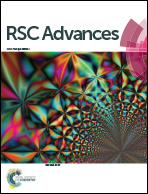Highly sensitive and selective toluene sensor based on Ce-doped coral-like SnO2†
Abstract
Coral-like SnO2 nanostructure was synthesized via a simple hydrothermal treatment in the presence of glucose. The characterization results showed that the size of coral-like SnO2 powders is about 13 nm with porous structure. The special surface area and the average size of pores are about 46.9 m2 g−1 and 7.61 nm, respectively. Subsequently, we investigated the gas-sensing properties of the sensors based on the coral-like SnO2. We chose CeO2 as a dopant and made three CeO2 doped sensors with 0.5%, 1.5%, and 2.5% for the mole ratio of Ce to Sn. The gas sensing tests indicated that CeO2 as the dopant can significantly enhance the gas selectivity toward toluene, and the sensor with 1.5% mole ratio showed the highest sensitivity toward toluene at 190 °C, which is much higher than that toward other VOC gases such as ethanol, acetone, and formaldehyde. The efforts in the research have proved that the CeO2 doped SnO2 could be a potential candidate of highly sensitive and selective gas sensors for toluene.


 Please wait while we load your content...
Please wait while we load your content...